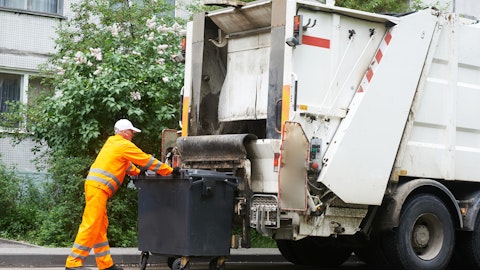Republic Services, Inc. (NYSE:RSG) Q3 2023 Earnings Call Transcript October 26, 2023
Republic Services, Inc. beats earnings expectations. Reported EPS is $1.54, expectations were $1.41.
Operator: Good afternoon, and welcome to the Republic Services’ Third Quarter 2023 Investor Conference Call. Republic Services is traded on the New York Stock Exchange under the symbol RSG. All participants in today’s call will be in a listen-only mode. [Operator Instructions] Please note, this event is being recorded. I would now like to turn the conference over to Aaron Evans, Vice President of Investor Relations.
Aaron Evans: Thank you. I would like to welcome everyone to Republic Services’ third quarter 2023 conference call. Jon Vander Ark, our CEO; and Brian DelGhiaccio, our CFO, for joining me as we discuss our performance. I would like to take a moment to remind everyone that some of the information we discuss on today’s call contains forward-looking statements, which involve risks and uncertainties and may be materially different from actual results. Our SEC filings discuss factors that could cause actual results to differ materially from expectations. The material that we discuss today is time-sensitive. If in the future, you listen to a rebroadcaster reporting in this conference call, you should be sensitive to the date of the original call, which is October 26th, 2023.

An industrial truck driving between waste management containers.
Please note that this call is property of Republic Services, Inc. Any redistribution, retransmission or rebroadcast of this call in any form without the express written consent of Republic Services is strictly prohibited. I want to point out that our SEC filings, our earnings press release, which includes GAAP reconciliation tables and a discussion of business activities, along with a recording of this call, are available on Republic’s website at republicservices.com. I want to remind you that Republic’s management team routinely participates in investor conferences. When events are scheduled, the dates, times and presentations are posted on our website. With that, I’d like to turn the call over to Jon.
Jon Vander Ark: Thanks Aaron. Good afternoon everyone and thank you for joining us. Our strong third quarter results reflect our focus on profitably growing the business. We produced revenue growth both organically and through acquisitions, while generating healthy margin expansion across our business. During the quarter, we delivered revenue growth of 6%, including 2% from acquisitions, generated adjusted EBITDA growth of 9% and expanded EBITDA margin by 70 basis points, report adjusted earnings per share of $1.54 and produced $1.8 billion of adjusted free cash flow on a year-to-date basis. We continue to effectively allocate capital by investing in acquisitions to create long-term value. Year-to-date, we have invested $947 million in acquisitions.
All transactions were in the recycling and waste space. The M&A environment remains active with opportunities in both the recycling and waste and Environmental Solutions businesses. We remain confident that we will exceed $1 billion of investment for the year. Year-to-date, we returned $671 million to shareholders through dividends and share repurchases. This includes $201 million of share repurchases completed during the third quarter as our leverage ratio returned to target levels. We continue to make progress, demonstrating the value of our complete set of products and offerings to customers while increasing the profitability of our Environmental Solutions business. Pricing realization in the Environmental Solutions business remains strong, and we continue to drive organic growth through cross-selling.
EBITDA margin in the Environmental Solutions business improved sequentially to 22.7% in the third quarter and expanded 390 basis points over the prior year. The results we are delivering are made possible by executing our strategy in support of our differentiated capabilities. Regarding customer zeal, our efforts to deliver industry-leading service continues to drive sustained customer loyalty and organic growth in the business. Our customer retention rate remained over 94% and we continue to see favorable trends in our Net Promoter Score, supported by our valuable service offerings and quality service delivery. Organic revenue growth remained strong during the quarter, with simultaneous increases in both price and volume. Core price and related revenue was 8.6% and average yield on related revenue was 7.2%, and organic volume growth and related revenue was 10 basis points.
Turning to our digital capabilities. The team continues to advance the implementation of digital tools that improve the experience for both customers and employees. The next phase of our digital operations is expected to drive additional productivity savings through route optimization, further improved safety performance, and provide more predictable service delivery to our customers. For example, we now have the ability to provide real-time customer notifications regarding expected service time on a given day. We are in the early stages of deploying advanced contamination over time and drive incremental revenue. Moving on to sustainability. We believe that our sustainability innovation investments in areas such as plastic circularity and renewable natural gas or a platform for profitable growth.
Development of our polymer centers remains on track. Construction of our Las Vegas Polymer Center is substantially complete, and we expect full scale operations to begin in November. Our Midwest Polymer center will be located in India. This center will be co-located with a Blue Polymers production facility with operations expected to begin in late 2024. The renewable natural gas projects being codeveloped with our partners are continuing to advance. I projects were online by the end of the third quarter, and we expect eight additional projects to be completed in 2024. We are making progress in our efforts to reduce greenhouse gas emissions, including our industry-leading commitment to fleet electrification. We expect to have 12 electric vehicles in operation by year-end and more than 60 EVs to be added to our recycling and waste collection fleet in 2024.
We now have 6 facilities with commercial EV charging infrastructure with more than 40 additional sites in various stages of development. We continue to be recognized as an employer of choice and are proud to be certified as a great place to work for the seventh consecutive year. Our team members remain highly engaged to ensure that we are delivering high-quality essential services that are valued by our customers. I now turn the call over to Brian, who’ll provide more details for the quarter.
Brian DelGhiaccio: Thanks Jon. Core price on total revenue was 7%. Core price on related revenue was 8.6% and which included open market pricing of 10.4% and restricted pricing of 5.7%. The components of core price on related revenue included small container of 12% and large container of 8.6% and residential of 8%. Average yield on total revenue was 5.8% and average yield on related revenue was 7.2%. We continue to price new and existing business ahead of cost inflation to drive margin expansion in the underlying business. Volume on total revenue and related revenue increased 10 basis points. The component of volume on related revenue included an increase in small container of 50 basis points and an increase in landfill of 3.5%.
Landfill was primarily driven by an 8.2% increase in special waste revenue. Volume growth was partially offset by a decrease in large container of 1.7% and a decrease in landfill C&D volumes of 6.2%, primarily due to a slowdown in construction-related activity. Moving on to recycling. Commodity prices were $112 per ton during the quarter. This compares to $162 per ton in the prior year. Recycling processing and commodity sales decreased revenue by 20 basis points during the quarter. We continue to see a steady recovery in fiber markets and plastics pricing has improved from recent lows. Our current average commodity price is approximately $120 per ton. Next, turning to our Environmental Solutions business. Third quarter Environmental Solutions revenue increased $8 million over the prior year.
On a same-store basis, Environmental Solutions contributed 40 basis points to internal growth during the quarter. Adjusted EBITDA margin for the Environmental Solutions business was 22.7% and an increase of 390 basis points compared to the prior year. Total company adjusted EBITDA margin expanded 70 basis points to 29.9%. Margin performance during the quarter included margin expansion in the underlying business of 100 basis points and a 30 basis point increase from one less workday. This was partially offset by a 20 basis point decrease from acquisitions, a 20 basis point decrease from recycled commodity prices and a 20 basis point decrease from net fuel. Year-to-date adjusted free cash flow was $1.8 billion. Similar to prior years, we expect to spend a disproportionate amount of our full year capital expenditures and cash taxes during the fourth quarter.
Year-to-date net capital expenditures of $935 million represents 56% of our projected full year spend and year-to-date adjusted cash taxes of $152 million represents approximately 60% of our projected full year spend. Total debt was $12 billion, and total liquidity was $2.3 billion. Our leverage ratio at the end of the quarter was 2.9 times. With respect to taxes, our combined tax rate and effects from solar investments resulted in an equivalent tax impact of 21.4% during the third quarter. The relatively lower tax rate included a $20 million favorable tax settlement from previous tax years, which added $0.06 of EPS during the quarter. We now expect an equivalent tax impact of approximately 24.5% for the full year. As noted in our earnings press release, we upwardly revised our full year adjusted earnings per share to be in the range of $5.46 to $5.49 primarily as a result of the lower tax rate.
We remain comfortable achieving the other components of full year financial guidance that we provided in July. I will now turn the call back to Jon. Actually, we’re going to open it up for Q&A.
Jon Vander Ark: Yeah, let me do one more section, please. We are proud of the results we delivered during the third quarter. Healthy contribution from our pricing strategy more than offset recycled commodity headwinds and cost inflation, which continues to moderate. Looking forward to 2024, we expect continued outsized growth in the recycling and waste and Environmental Solutions businesses, supported by pricing ahead of underlying costs, cross-selling our complete set of products and services and capitalizing on value-creating acquisition opportunities. We also expect financial contribution from the investments made in sustainability innovation, including plastic circularity and renewable natural gas projects. The fundamentals of our business remain strong and supportive of continued growth in revenue, EBITDA and free cash flow along with margin expansion.
We plan to provide detailed guidance on our earnings call in February. Now with that, operator, I would like to turn it over for questions.
See also 20 Biggest Social Media Mistakes By Companies in 2023 and 16 Most Expensive Furniture Brands in the World.
Q&A Session
Follow Republic Services Inc. (NYSE:RSG)
Follow Republic Services Inc. (NYSE:RSG)
Operator: We will now begin the question-and-answer session. [Operator Instructions] The first question today comes from Toni Kaplan with Morgan Stanley. Please go ahead.
Toni Kaplan: Thanks very much. Not looking for guidance in 2024, but just maybe, if you could just provide some initial thoughts on pricing, maybe on the separated into open market and restricted, how those should hold up? Thank you.
Jon Vander Ark: Yeah. We’re not providing guidance today, obviously, on 2024, but we expect – the outlook is positive. So I think about high to mid- to high single-digit revenue growth, and we’ll grow free cash flow and EBITDA margin faster than that, and that gets to your pricing question, we just — pricing will come down nominally as inflation comes down, but we’ll still be pricing ahead of our cost inflation, which should lead to that formula where we’re going to grow the bottom line a little faster than the top line.
Toni Kaplan: Great. And then just thinking about some of the expense drivers. We’ve heard from peers and from you as well in prior quarters that the equipment availability has been a little bit better, that retention has been improving. Is there any way to size some of those benefits? Just trying to think about those on a go-forward basis. Thanks.
Jon Vander Ark: We’re certainly – we talked about cost inflation modulating in the second half, and we’re certainly seeing that. So you can see that in some of the cost categories, labor, maintenance, certainly a bright spot. The supply chain there, maybe getting incrementally better, but still, we’re not going to get all the trucks we want this year. But I think if you see the improvement in the maintenance, that really speaks to the underlying cost of parts inflation has certainly improved versus the first half. And we expect those costs to continue to modulate into next year as well.
Toni Kaplan: Thanks very much.
Operator: The next question comes from Bryan Burgmeier with Citi. Please go ahead.
Bryan Burgmeier: Good afternoon. Thanks for taking the question. Jon, Brian, apologies if I missed this, but when I look at the EBITDA and free cash flow bridge is provided in the press release, it seems like net income kind of steps up consistent with the tax rate changes we’ve talked about. But it maybe doesn’t flow through to cash. Just wondering what I might be missing? Is it maybe a change to an adjusted number on how your cash taxes, is there changes to working capital? Any detail you could provide would be great.
Brian DelGhiaccio: Yes. Look, as you mentioned, we raised the full year EPS guidance predominantly due to the relatively lower tax rate. There is a cash component to that as well. That is somewhat offset by relatively higher interest rates than we normally thought, which is flowing through to cash interest, and that’s why your adjusted free cash flow remains relatively consistent with what we previously provided.
Bryan Burgmeier: Got it. Thanks for that detail And last question for me. I’m just wondering if you can maybe try to characterize the M&A market within Environmental Solutions. You’ve obviously been very busy with acquisitions, but we haven’t seen any deals and yes yet. I’m just wondering if M&A is a little bit slower than you developed or if everything is moving along and maybe it just comes down to timing? Thanks gentlemen.
Jon Vander Ark: Yes, it really comes down to timing. The pipeline is strong, lots of opportunities, lots of conversations. And we remain incredibly disciplined in terms of our financial strategic lens and our financial lens on that, but we feel certainly optimistic through the remainder of the year and into the first half of next year that there’s a number of attractive opportunities in that space.
Operator: The next question comes from Tyler Brown with Raymond James. Please go ahead.
Tyler Brown: Hey, good afternoon, guys.
Jon Vander Ark: Hey, Tyler.
Tyler Brown: So Brian, I think restricted pricing actually accelerated again to 5 7 here in Q3. Do you think that this is going to prove the high watermark, or do you think we get maybe one more quarter of acceleration? And then we kind of hit that second derivative?
Jon Vander Ark: I think we’re near it, quite honestly, Tyler here. Again, we talked about the relationship between CPI-based pricing starting to step down, but water sewer trash and garbage trash stepping up. And right now, I think they’re somewhat offsetting each other. We think that to the question earlier about as you look forward, we do think that the restricted base pricing does step down sequentially 2024 from 2023, but again, it still stays above that longer-term average.
Tyler Brown: Yes. Okay. That’s helpful. And then — so Jon, I think last quarter, there was some talk about kind of hitting a ceiling in certain places in ES with some of the pricing actions. It said that you were — you kind of said that you were moving forward on that front. But just curious if you can give us an update there. Is pricing good in ES? Are you starting to see some churn. And just are you seeing any impacts from the economy in that business specifically?
Jon Vander Ark: Yes. No, pricing remains strong. We certainly remain committed on that. There’s sort of that’s a customer churn on that portfolio. Some of that’s permanent work, some of that is event work, and we’re trading off some low-margin work, and we’re adding to that very attractive cross-sell work. And so lots of really attractive growth opportunities in that space, but we’re never going to do work for free, and we’re always going to start out with price on that. So in the macro environment in manufacturing and ES broadly is a bit mixed. So the upstream oil and gas has been slower. Hopefully, a couple of big deals announced here that, that will ignite some increased activity there in Q4 and into next year. Automotive, obviously, has been a little bit challenged here with the labor activity.
But then other parts of the petrochemical complex have been very, very strong. And overall, we’re happy with the results and still feel very positive going into 2024 in terms of the demand environment.
Tyler Brown: Yes. Okay. And just my last one here, a couple of housekeeping items. But based on what we know today, what is the expected M&A rollover benefit next year? And then based on what we know today with the RNG and the polymers, what is the incremental benefit to 2024 EBITDA from those?


